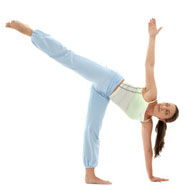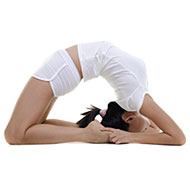Half Moon Pose
Yoga in an ancient form of exercise that has, over the years, gained considerable popularity owing to its positive benefits on the body.
In terms of representation, in the Half-moon Pose (Ardha Chandrasana), the extension of the torso in one direction and the uplifted leg pointing in the opposite direction depict the flat surface of a half moon.
The extended arms show the brilliance of the radiation emanating from the moon. It is a great pose for learning the art of balancing and increasing awareness. This pose can also help in easing lower-back related problems, sciatica pain, and various lumbar aches.
Half-moon pose
In yogic mythology, the moon is the symbol of brilliance and light. The Half-moon Yoga Pose or the Ardha Chandrasana is an inversion pose that targets areas like the legs, buttocks, and hips, and it has a number of benefits on a person’s health and well-being. The benefits are both mental and physical. It is believed that the pose helps in relieving stress and also improves digestion. A few preparatory poses will prepare the practitioner for performing this standing yoga pose with ease.
Steps
The Half-moon Pose steps are as follows:
- To begin the yoga pose, start with Triangle Pose (Trikonasana), while the left hand rests on your hip.
- Then, bend your right knee slightly by moving it forward and away from you.
- Move your right hand in the forward direction as well, a few inches away from the right foot.
- Exhale, and depress your right hand and your right heel against the floor for better balance.
- Lift your left leg up and bring it parallel to the floor.
- Then, raise your left hand and align it with your left leg; the weight of your body should be borne by your right leg.
- Look up and concentrate on your fingers and stay in this pose for a few seconds.
- Then, lower the raised leg to the floor and exhale simultaneously.
- Perform the same steps on the opposite side.
In case you want added support while performing the Half-moon Pose, then you can use blocks of different heights. As you become more comfortable, you can keep on reducing the height of the block.
Precautions
While there are not Half-moon Pose precautions as it is considered a safe pose, some factors to keep in mind when performing the Half-moon Pose are as follows.
- Those people who are suffering from conditions like diarrhea, insomnia, blood pressure, back or shoulder pain must not perform this pose.
- Those who are suffering from headache or migraine must not perform this pose.
- Those who suffer from low blood pressure should also avoid this yoga pose as it is not safe for them.
Beginner's tip
If you are a beginner, you must follow the steps of the Half-moon Pose carefully. As a beginner’s tip for Half-moon Pose, you are suggested to use blocks for better support.
Many beginners usually face problems when touching the floor while performing this yoga pose. In such a situation blocks are of a great help. One can start by using block of highest height. Slowly as sense of balance and comfort level improves, you can lower the height of the block. If you have pain in your neck, then keep your head level and look in the forward direction. In case the pain persists, then you must discontinue practicing this yoga pose.
Benefits to the body
Practicing the Half-moon Pose regularly provides a wealth of benefits to the body parts. A few benefits are as follows:
- The Half-moon Pose helps in cutting fat from the abdomen, hips, buttocks and waistline.
- It improves digestion and reduces gastrointestinal-related problems, thus it reduces the risk of central obesity in the body.
- The pose is said to improve bowel movement.
- It provides a good stretch and helps in opening up the shoulder joints.
- It helps in reducing physical and psychological stress levels.
- Allows for improvement in coordination and sense of balance.
- Stretches the hamstrings, calves, chest, spine, shoulder, and groin.
Therapeutic Applications
The therapeutic applications of Half-moon Pose are numerous, and it can help in the management and treatment of many conditions. A few common therapeutic applications are listed below:
- Menstrual pain and regulation of cycle
- Constipation
- Fatigue
- Sciatica pain
- Indigestion
- Gastritis
- Anxiety
- Back ache
- Lumbar pains
- Osteoporosis
Variations
When one gets used to performing this yoga pose, then one can try a few variations to Half-moon Pose in order to make it more challenging. Variations can also be used to simplify the pose for beginners. Some of the variations are listed below.
- To make the pose more challenging, one can raise the lower hand and keep it on the thigh of the leg on which you are standing. Then, you need to balance your whole body on solely one leg and maintain this posture for about 15 to 30 seconds.
- For beginners, in another variation of the pose, one can use the wall as a prop and use it for support.
Preparatory poses
The preparatory poses for Half-moon Pose help the practitioner in easily moving into the pose. A few preparatory poses are as follows:
- "The Bound Angle Pose" or "The Baddha Konasana"
- "The Reclining Bound Angle Pose" or "The Supta Baddha Konasana"
- "The Wide-Legged Forward Bend" or "The Prasarita Padottanasana"
- "The Standing Forward Bend" or "The Uttanasana"
- "The Extended Triangle Pose" or "The Utthita Trikonasana"
- "The Reclining Big Toe Pose" or "The Supta Padangusthasana"
- "The Tree Pose" or "The Vrksasana"
- "The Hero Pose" or "The Virasana"
Follow up poses
The Half-moon Pose is usually positioned somewhere in the middle of the standing pose series. However, there are no fixed rules about the follow up poses for this pose. This yoga pose in usually sequenced after the Extended Triangle Pose or Utthita Trikonasana. A few follow up poses that one can try are as follows:
- "The Wide-Legged Forward Bend" or "The Prasarita Padottanasana"
- "The Revolved Triangle Pose" or "The Parivrtta Trikonasana"



